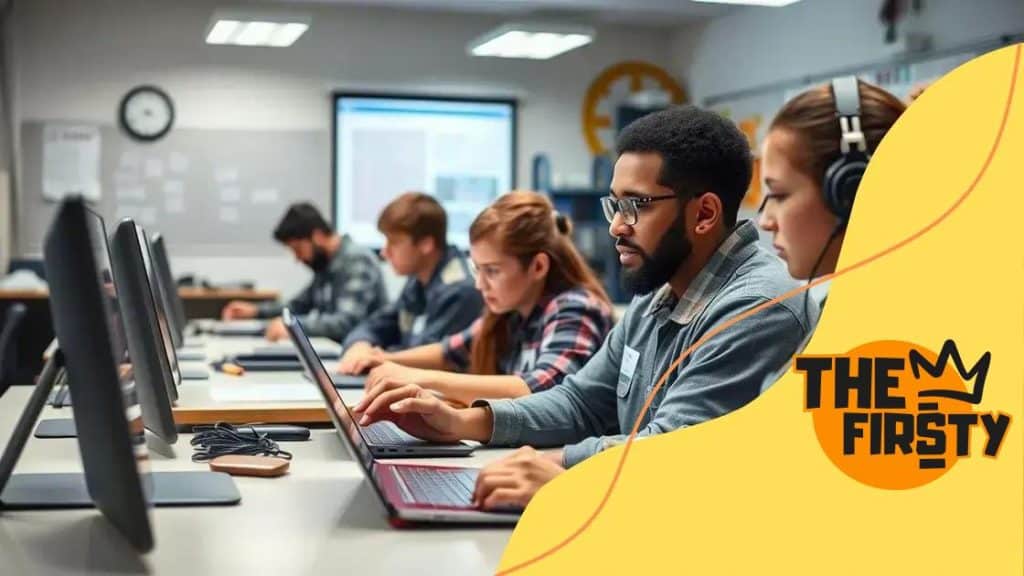The future of vocational education in the digital age

Anúncios
Preparing for careers in a digital world requires developing digital literacy, essential soft skills, and gaining real-world experience through internships, while staying updated on industry trends to meet the evolving demands of the workforce.
The future of vocational education in the digital age presents a unique opportunity to rethink how we approach learning and job readiness. Have you considered how technology changes the landscape of skills training? Let’s dive in.
Anúncios
Understanding vocational education today
Understanding vocational education today is crucial for students looking to build successful careers. This type of education focuses on practical skills and knowledge needed for specific jobs, helping learners prepare for the workforce effectively.
Vocational education is different from traditional academic pathways. It emphasizes hands-on experience, which gives students a competitive edge. Many programs are designed with input from industries, ensuring that the training provided meets current job market demands.
Key Features of Vocational Education
Some of the main aspects that define modern vocational education include:
Anúncios
- Real-world training that mirrors workplace conditions.
- Shorter duration compared to traditional degrees.
- Flexible learning options, including online courses.
- Strong collaboration between educational institutions and industries.
This education model is highly adaptable, allowing learners to choose paths that suit their interests and job market needs. The rise of technology has also transformed vocational training. Online platforms now offer extensive resources, making education more accessible. Students can engage in interactive learning experiences that deepen their understanding of vital skills.
Furthermore, vocational education helps to address skill gaps in various sectors. By tailoring programs to meet the requirements of employers, schools can ensure that students enter the job market ready to contribute. This not only benefits the graduates but also strengthens the economy as a whole.
Overall, understanding vocational education today means recognizing its relevance and importance in preparing individuals for tomorrow’s employment opportunities. As industry needs evolve, so too will the methods and frameworks of vocational training, making it an essential part of education.
The impact of technology on learning
The impact of technology on learning is profound and reshapes how students engage with educational content. Today, learners benefit from a variety of digital tools and platforms that enhance their educational experience.
Modern educational technologies include online courses, interactive simulations, and mobile apps. These resources provide students with flexibility and access to a wealth of information. Engaging with these tools encourages active participation and keeps students motivated.
Advantages of Technology in Education
When integrating technology into education, there are several notable advantages:
- Personalized learning experiences that cater to individual needs.
- Access to diverse resources and learning materials.
- Opportunities for collaboration through online platforms.
- Instant feedback from quizzes and assignments.
Virtual classrooms have emerged as an effective way to deliver lessons. They allow students to connect from anywhere in the world, breaking down geographical barriers. This means that learners can access quality education without needing to be physically present in a traditional classroom.
Furthermore, technology fosters critical thinking and problem-solving skills. For instance, students can engage with educational games and simulations that challenge them to think creatively. This hands-on approach makes learning more engaging and relevant.
As the work environment continues to evolve, having technological skills is vital for job readiness. Students who become familiar with tech tools during their education will be better equipped to thrive in the modern workforce.
In conclusion, the impact of technology on learning is crucial for fostering a new generation of skilled workers. As technology advancements continue to rise, educational methods will adapt, ensuring effective learning experiences for students everywhere.
Skills needed for the digital workforce

Skills needed for the digital workforce are constantly evolving, reflecting the demands of modern industries. As technology advances, workers must adapt by acquiring new abilities that enhance their employability.
A strong foundation in digital literacy is essential. This includes the ability to use software, navigate online platforms, and understand basic coding concepts. Familiarity with digital tools enables individuals to work efficiently and communicate effectively in a tech-driven environment.
Critical Skills for Success
Some key skills that are essential for thriving in the digital workforce include:
- Problem-solving capability to tackle challenges creatively.
- Collaboration skills to work effectively in team settings.
- Adaptability to adjust to new tools and technologies quickly.
- Communication skills for clear and effective information exchange.
Moreover, knowledge of data analysis is becoming increasingly important. Understanding how to interpret and use data helps organizations make informed decisions. This skill is highly sought after across various fields.
In addition, having a grasp of cybersecurity principles is beneficial. As cyber threats grow, workers need to know how to protect sensitive information and understand the importance of safe online practices. This skill helps maintain trust in digital operations.
Furthermore, creativity is a highly valued trait in the digital age. Employers seek individuals who can bring fresh ideas and innovative solutions to the table. Encouraging creative thinking can lead to breakthroughs and improvements in processes.
Overall, the skills needed for the digital workforce encompass a blend of technical knowledge, soft skills, and creative abilities. As the landscape continues to shift, ongoing learning and adaptation will be crucial for career success.
Innovative training methods for students
Innovative training methods for students are transforming education, making learning more engaging and effective. As the demands of the workforce change, so do the approaches used to prepare students for their careers.
One effective method is project-based learning. This approach encourages students to work on real-world projects that require critical thinking and collaboration. Through hands-on experiences, learners can see the relevance of their studies, which helps motivate them.
Utilization of Technology
Integrating technology into the classroom is another innovative method that enhances learning. By using tools such as:
- Virtual reality for immersive experiences.
- Online simulations to practice skills in a safe environment.
- Mobile apps for learning and practice on-the-go.
- Interactive platforms for collaboration and feedback.
Technology aids in more personalized learning experiences. Students can progress at their own pace, addressing gaps in understanding without feeling pressured by their peers. This flexibility is crucial in catering to different learning styles.
Furthermore, experiential learning is a method that allows students to learn by doing. This could involve internships, apprenticeships, or community service projects. These experiences not only build skills but also instill a sense of responsibility and professionalism in students.
Peer teaching is another innovative method where students learn from each other. When students explain concepts to their classmates, it reinforces their own understanding while building communication and teamwork skills. This collaborative learning environment prepares them for future workplaces.
In conclusion, innovative training methods for students provide them with skills and knowledge that are crucial in today’s fast-paced world. By incorporating various teaching techniques and technologies, educators can create a dynamic learning experience that captures students’ interest and prepares them for success.
Preparing for careers in a digital world
Preparing for careers in a digital world involves equipping students with the skills and knowledge to succeed in an increasingly tech-driven environment. As industries evolve, the expectations from future employees change, making it essential for educational institutions to adapt their training methods.
One key aspect is developing digital literacy. This includes understanding various technologies, software, and platforms commonly used in different fields. By familiarizing students with tools like spreadsheets, presentation software, and communication platforms, educators prepare them for everyday tasks in the workplace.
The Importance of Soft Skills
Along with technical skills, soft skills are crucial. Employers often look for individuals who can:
- Communicate effectively with team members.
- Adapt quickly to new challenges and technologies.
- Think critically to solve problems.
- Collaborate well in diverse teams.
Encouraging teamwork through group projects and presentations helps students practice these essential skills. Furthermore, fostering a growth mindset allows them to embrace continuous learning, necessary for keeping pace with technological advancements.
Internships and hands-on experiences play a vital role in this preparation. They provide students with a glimpse into the working world, helping them apply their knowledge and skills in real-life situations. Such experiences also allow students to build professional networks, which can be invaluable in their careers.
Additionally, understanding industry trends prepares students for future employment. Keeping up with emerging technologies, such as artificial intelligence and data analytics, will position them as valuable candidates. Schools can implement workshops and lectures from industry professionals to keep students informed.
Finally, exploring various career options within the digital landscape helps students identify their interests and aspirations. This exploration can include courses in programming, digital marketing, graphic design, or cybersecurity, guiding students to paths that align with their strengths.
FAQ – Preparing for Careers in a Digital World
What skills are most important for the digital workforce?
Key skills include digital literacy, communication, critical thinking, and adaptability to new technologies.
How can students gain real-world experience?
Students can pursue internships, apprenticeships, or participate in community service projects to gain hands-on experience.
Why are soft skills important in the digital age?
Soft skills like teamwork and problem-solving are essential for collaboration and success in diverse work environments.
How can schools help students stay updated on industry trends?
Schools can invite industry professionals to share insights and offer workshops that focus on emerging technologies and market needs.





